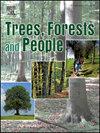The divergent advancements of sap phenology in maple under warming conditions can shorten the sugar season
IF 2.7
Q1 FORESTRY
引用次数: 0
Abstract
Climate change raises concerns for the maple syrup industry, mainly regarding the expected changes in the timings of the sugar season and the resulting uncertainty of sap yield. This study investigates the temporal relationships between the environmental factors and sap phenology (i.e., timings of the onset and ending of sap season) in sugar maple (Acer saccharum Marsh.) during 2018–2022 at the northern limit of the species in Quebec, Canada, and predicts the impact of warming under greenhouse gas emission scenarios (RCP 2.6, 4.5, and 8.5). March and April temperatures are correlated to the onset and ending of sap exudation, occurring on average on DOY (day of the year) 86 and 133, respectively. Sap exudation corresponds with the start of snowmelt and the consequent increase in soil water content. Complete snowmelt and the increase in soil temperature coincide with the ending of sap exudation. Our partial least squares regressions estimate an advancement of up to 20 days for the start and 26 days for the end of sap production by 2100 at RCP 8.5. The predictions suggest a divergent advancement of the onset and ending of sap production under warming, resulting in a shorter duration of the sugar season. The earlier sap season represents an important challenge for producers, who will need to adjust their activities in the sugarbushes to match the warmer conditions predicted for late winter and early spring. Any delay in tapping will increase the risk of substantial losses in production, especially in the context of a shorter sap season.
暖化条件下枫树液物候的分化推进可以缩短糖季
气候变化引起了人们对枫糖浆行业的担忧,主要是关于糖季时间的预期变化以及由此导致的树液产量的不确定性。本文研究了2018-2022年加拿大魁北克北部地区糖槭(Acer saccharum Marsh.)树液物候(即树液季节开始和结束的时间)与环境因子的时间关系,并预测了温室气体排放情景(RCP 2.6、4.5和8.5)下气候变暖的影响。3月和4月的温度与树液渗出的开始和结束有关,平均分别发生在DOY(一年中的一天)86和133。树液渗出与融雪的开始和随之而来的土壤含水量的增加相对应。完全融雪和土壤温度的升高与树液渗出的结束同时发生。我们的偏最小二乘回归估计,到2100年,在RCP 8.5的情况下,sap生产的开始将提前20天,结束将提前26天。这些预测表明,在变暖的情况下,树液生产的开始和结束出现了不同的进展,导致糖季的持续时间缩短。提早的树液季节对生产者来说是一个重要的挑战,他们需要调整他们在甘蔗丛中的活动,以适应预计的冬末和早春的温暖条件。开采的任何延迟都将增加生产重大损失的风险,特别是在树液季节较短的情况下。
本文章由计算机程序翻译,如有差异,请以英文原文为准。
求助全文
约1分钟内获得全文
求助全文
来源期刊

Trees, Forests and People
Economics, Econometrics and Finance-Economics, Econometrics and Finance (miscellaneous)
CiteScore
4.30
自引率
7.40%
发文量
172
审稿时长
56 days
 求助内容:
求助内容: 应助结果提醒方式:
应助结果提醒方式:


